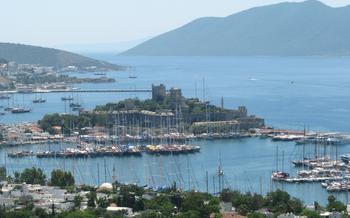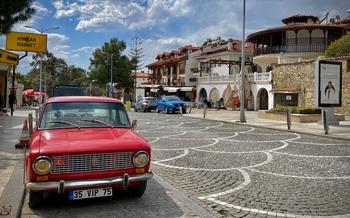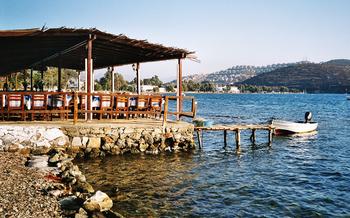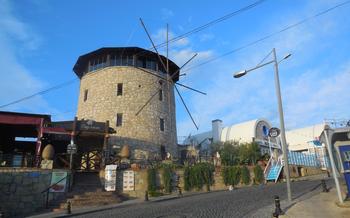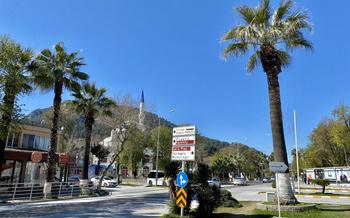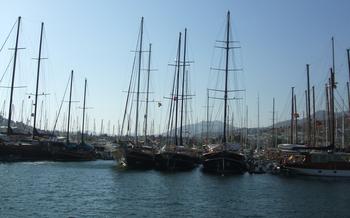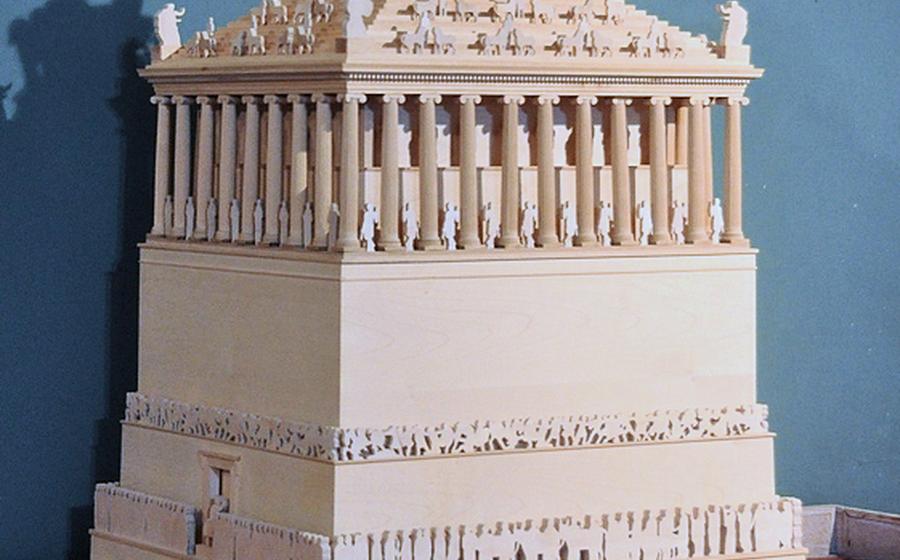
Mausoleum at Halicarnassus
- History of the Mausoleum at Halicarnassus:
- Location and Access
- Architectural Features
- Sculptures and Decorations
- Discovery and Excavation
- Reconstruction and Restoration Efforts
- Visiting the Mausoleum
- Interactive Exhibits and Displays
- Local Culture and Traditions
- Photography and Videography
- Souvenirs and Merchandise: Preserving Memories and Supporting Local Artisans
- Responsible Tourism
- Insider Tip: Unveiling the Mausoleum's Hidden Chamber
History of the Mausoleum at Halicarnassus:
The Mausoleum at Halicarnassus stands as a testament to the grandeur and opulence of the ancient world. Constructed in the 4th century BC, this magnificent tomb was commissioned by Mausolus, a satrap or governor in the Achaemenid Empire, as a final resting place for himself and his beloved wife, Artemisia. The Mausoleum's awe-inspiring design and intricate craftsmanship earned it a place among the Seven Wonders of the Ancient World, solidifying its status as a symbol of power, wealth, and architectural ingenuity.
The Mausoleum's colossal dimensions, measuring approximately 45 meters in height and 35 meters in width, were a testament to Mausolus's authority and prestige. Its exterior was adorned with intricate carvings and sculptures, depicting scenes from Greek mythology and the life of Mausolus himself. The interior was equally lavish, featuring a grand burial chamber that housed the remains of Mausolus and Artemisia.
The Mausoleum's construction showcased a harmonious blend of Greek and Persian architectural styles, reflecting the diverse influences that shaped the Achaemenid Empire. Its stepped podium, adorned with intricate reliefs, supported a colonnade of Ionic columns, while the pyramidal roof added a distinctly Egyptian touch to the structure.
The Mausoleum's grandeur and symbolism extended beyond its physical presence. It stood as a symbol of the wealth and power of the Achaemenid Empire, demonstrating the extent of their influence and control over the region. The Mausoleum's construction and design also reflected the growing cultural exchange between the East and the West, as Greek artistic traditions intermingled with Persian influences to create a unique and awe-inspiring masterpiece.
Location and Access
The Mausoleum at Halicarnassus is situated in the captivating town of Bodrum, Turkey, a place steeped in history and natural beauty. To reach this ancient wonder, visitors can embark on a picturesque journey from Bodrum city center, traversing a distance of approximately 2 kilometers. The Mausoleum's proximity to the city center makes it easily accessible on foot, allowing visitors to soak in the vibrant atmosphere of Bodrum while making their way to this iconic landmark.
For those seeking a more convenient option, public transportation stands ready to whisk them away to the Mausoleum's doorstep. Regular buses depart from strategic locations in Bodrum, ensuring seamless connectivity to this architectural marvel. Simply hop on the bus and let the city's rhythm carry you to your destination.
The Mausoleum's accessibility extends to visitors with disabilities and special needs, ensuring that everyone has the opportunity to witness its grandeur. Wheelchair ramps and accessible pathways have been thoughtfully incorporated, enabling visitors of all abilities to navigate the site with ease and comfort.
Bodrum's tapestry of landmarks and attractions offers a wealth of options for visitors seeking a comprehensive cultural experience. The Bodrum Castle, a formidable fortress that has stood the test of time, beckons history enthusiasts to delve into its tales of conquest and resilience. The Bodrum Museum of Underwater Archaeology unveils the secrets of the deep, showcasing an array of captivating artifacts recovered from the Aegean Sea. And for those seeking a moment of tranquility amidst the historical wonders, the Mausoleum Beach beckons with its pristine sands and inviting waters, offering a refreshing respite from the exploration of ancient marvels.
Architectural Features
The Mausoleum at Halicarnassus, considered one of the Seven Wonders of the Ancient World, stood as a testament to the architectural brilliance of its time. Its unique design showcased a harmonious blend of Greek and Persian styles, creating a masterpiece that defied conventional norms.
The exterior of the Mausoleum was a sight to behold, featuring a stepped podium that elevated the structure to prominence. Majestic Ionic columns adorned the facade, reaching towards the sky like sentinels guarding a treasure. Intricate friezes, carved with scenes of mythology and history, wrapped around the building, adding depth and narrative to its exterior.
Inside, the Mausoleum revealed an equally impressive interior. The burial chamber, the heart of the structure, held the remains of Mausolus and Artemisia. Elaborate decorations adorned the walls, depicting scenes from the lives of the deceased and paying homage to their power and legacy.
The Mausoleum's architectural innovations were groundbreaking for its time. Its use of a stepped podium, the combination of Greek and Persian elements, and the intricate sculptural decorations set new standards for monumental architecture. These innovations would go on to influence architectural styles throughout the ancient world, leaving a lasting legacy on the evolution of architecture.
Sculptures and Decorations
The Mausoleum at Halicarnassus was adorned with an impressive collection of sculptures, which are considered masterpieces of ancient Greek art. These sculptures were created by some of the most renowned artists of the time, including Scopas, Bryaxis, Timotheus, and Leochares.
The most famous sculptures from the Mausoleum are the colossal statues of Mausolus and Artemisia, which stood at the top of the monument. These statues were made of white marble and depicted Mausolus seated on a throne, while Artemisia stood beside him. The statues were highly realistic and detailed, capturing the individual features and expressions of the subjects.
In addition to the statues of Mausolus and Artemisia, the Mausoleum was also decorated with numerous other sculptures, including friezes depicting mythological scenes and figures. These friezes were carved in high relief and displayed a variety of subjects, including battles, hunts, and religious ceremonies. The sculptures from the Mausoleum are not only remarkable for their artistic quality but also for their historical significance. They provide valuable insights into the culture, beliefs, and artistic traditions of the ancient Greeks.
The impact of the Mausoleum's sculptures on the development of Hellenistic and Roman art was profound. The Mausoleum's innovative use of sculpture, particularly the colossal statues and the high relief friezes, became a model for later artists and architects. The Mausoleum's sculptures also played a significant role in the transmission of Greek artistic traditions to the Roman world.
Discovery and Excavation
The rediscovery of the Mausoleum at Halicarnassus in the 19th century marked a significant milestone in the field of archaeology. British archaeologists, driven by a fascination for ancient history and the allure of uncovering lost treasures, embarked on a journey to unearth the secrets of this legendary structure.
The excavation process was not without its challenges. The Mausoleum had been buried under centuries of sand and debris, and the archaeologists had to meticulously remove these layers to reveal the hidden wonders beneath. The painstaking work required patience, precision, and a deep understanding of archaeological techniques.
As the excavation progressed, the team uncovered a treasure trove of artifacts and remains that provided valuable insights into the Mausoleum's history and grandeur. Fragments of exquisite sculptures, intricately carved inscriptions, and remnants of the building's once-magnificent structure were brought to light, shedding new light on the architectural marvels of the ancient world.
The discovery of the Mausoleum was a pivotal moment in the study of ancient history and architecture. It sparked a renewed interest in the region and led to further excavations and research that have contributed to our understanding of the rich cultural heritage of Bodrum and the surrounding area.
The ongoing research and studies conducted at the Mausoleum site continue to provide valuable insights into the construction techniques, artistic styles, and historical significance of this remarkable monument. These investigations not only help us piece together the puzzle of the past but also serve as a reminder of the enduring legacy of ancient civilizations.
Reconstruction and Restoration Efforts
Over the years, there have been ongoing efforts to reconstruct and restore the Mausoleum to its former glory. These initiatives aim to preserve and showcase the architectural masterpiece for future generations. However, the process is not without its challenges.
Replicating the original design and materials is a daunting task. Historians, architects, and conservators must meticulously study the remaining fragments and historical records to accurately recreate the Mausoleum's grandeur. Modern techniques, such as 3D modeling and laser scanning, are employed to ensure precision and authenticity.
The reconstruction process involves careful consideration of the original materials and construction methods. Quarrying and shaping massive blocks of stone, similar to those used in ancient times, is a laborious and specialized task. Craftspeople skilled in traditional techniques collaborate with modern engineers to ensure structural integrity and historical accuracy.
Despite the challenges, the reconstruction efforts are driven by a deep appreciation for the Mausoleum's cultural significance. Preserving this ancient wonder serves as a testament to the ingenuity and artistry of our ancestors. It also contributes to our understanding of ancient architectural practices and the development of architectural styles.
The ongoing debates and discussions surrounding the reconstruction efforts center on the ethical implications of recreating a lost masterpiece. Some argue that the Mausoleum should remain in its current state, as a testament to the passage of time and the inevitable decay of all human creations. Others believe that the reconstruction is a necessary step to preserve and share this cultural heritage with the world.
Ultimately, the decision of whether to reconstruct the Mausoleum is a complex one, with valid arguments on both sides. However, the ongoing efforts to restore and preserve this ancient wonder demonstrate our commitment to appreciating and safeguarding our shared cultural heritage.
Visiting the Mausoleum
Practical considerations are essential for a fulfilling visit to the Mausoleum at Halicarnassus. It is open to the public daily, except for Mondays, from 8 am to 5 pm. Ticket prices are reasonable, and guided tours are available for a more in-depth experience.
To make the most of your visit, plan your trip during the shoulder seasons (spring or autumn) to avoid the summer crowds. This will allow you to explore the Mausoleum at a more leisurely pace and capture stunning photos without hordes of tourists in the background.
Before your visit, familiarize yourself with the Mausoleum's layout and history. This will enhance your appreciation of the site and allow you to fully grasp its significance. Consider bringing comfortable shoes as you will be doing a fair amount of walking.
The Mausoleum is located in a bustling area, so you won't have to worry about finding food or refreshments. Several restaurants, cafes, and shops are nearby, catering to the needs of visitors.
Whether you're a history buff, an architecture enthusiast, or simply someone with a curious mind, a visit to the Mausoleum at Halicarnassus promises to be an unforgettable experience. Let this ancient wonder transport you back in time and marvel at the ingenuity and artistry of our ancestors.
Interactive Exhibits and Displays
The Mausoleum at Halicarnassus offers a range of interactive exhibits and displays that enhance the visitor experience and bring the ancient wonder to life. These interactive elements provide a deeper understanding of the Mausoleum's history, significance, and architectural features.
One of the highlights is the virtual reality experience, which allows visitors to step back in time and see the Mausoleum as it stood in its original glory. This immersive experience transports visitors to the ancient world, offering a unique perspective on the Mausoleum's grandeur and majesty.
Multimedia presentations and audio guides are also available, providing detailed information about the Mausoleum's construction, design, and symbolism. These interactive tools help visitors explore the Mausoleum's rich history and cultural significance at their own pace.
Through these interactive exhibits and displays, the Mausoleum becomes more than just a historical site; it transforms into a living and breathing testament to the ingenuity and artistry of the ancient world. Visitors can engage with the Mausoleum on a deeper level, gaining insights into its construction techniques, architectural innovations, and the stories behind its creation.
These interactive elements are not just educational tools; they also create a memorable and immersive experience for visitors. By combining cutting-edge technology with historical knowledge, the Mausoleum at Halicarnassus offers a truly unique and engaging experience that leaves a lasting impression on visitors of all ages.
Local Culture and Traditions
The Mausoleum at Halicarnassus holds immense cultural significance for the local community in Bodrum. It is a symbol of their rich history and a source of pride. The Mausoleum's enduring legacy has influenced local traditions and customs, making it an integral part of the region's cultural fabric.
One of the most prominent traditions associated with the Mausoleum is the annual festival held in its honor. During this festival, locals gather to celebrate the Mausoleum's heritage and its connection to the region. Traditional dances, music, and performances are showcased, creating a vibrant and festive atmosphere.
The Mausoleum has also left its mark on local cuisine. Several dishes and delicacies are named after the Mausoleum or inspired by its history. These dishes often incorporate local ingredients and flavors, reflecting the region's unique culinary traditions.
Furthermore, the Mausoleum's impact extends to the local economy and tourism industry. It is a major attraction for visitors worldwide, drawing in history enthusiasts, culture seekers, and tourists alike. The Mausoleum's presence has contributed to the growth of Bodrum's tourism sector, generating revenue and creating employment opportunities for the local community.
In essence, the Mausoleum at Halicarnassus is deeply intertwined with the local culture and traditions of Bodrum. Its legacy continues to shape the region's identity and contributes to its vibrant cultural heritage.
Photography and Videography
Capturing the grandeur and beauty of the Mausoleum through photography and videography is a popular activity among visitors. However, it's important to be mindful of the guidelines and restrictions in place to preserve the integrity of the site. Here are some tips to help you capture stunning visuals:
Respect the Rules: Before taking any photos or videos, make sure you understand and adhere to the rules and regulations set by the Mausoleum authorities. Some areas may have restrictions or require special permission for photography.
Choose the Right Equipment: To capture the Mausoleum's intricate details and vastness, a wide-angle lens is recommended. A tripod can help stabilize your camera for sharp and steady shots.
Find the Best Angles: Experiment with different angles to capture the Mausoleum's grandeur. Shoot from a low angle to emphasize its height or from a distance to capture its majestic presence in the landscape.
Play with Light: The golden hour, just after sunrise or before sunset, offers the most flattering light for photography. The warm hues can enhance the texture and colors of the Mausoleum's exterior.
Capture the Details: Don't just focus on the overall structure. Take close-up shots of the intricate carvings, sculptures, and inscriptions to capture the artistic details that make the Mausoleum unique.
Use Video for a Dynamic Experience: If you're into videography, capture footage that showcases the Mausoleum from different perspectives. Use slow-motion shots to highlight its grandeur or create a time-lapse video to show the changing light and shadows throughout the day.
Share Your Work: Share your photos and videos online using relevant hashtags to inspire others to visit the Mausoleum. Tag the official social media accounts of the Mausoleum or Bodrum to increase your reach.
Souvenirs and Merchandise: Preserving Memories and Supporting Local Artisans
At the Mausoleum at Halicarnassus, visitors can find a treasure trove of souvenirs and merchandise that capture the essence of this ancient wonder. From intricate replicas of the Mausoleum's architectural features to finely crafted jewelry inspired by the sculptures that adorned its exterior, there's something for every taste and budget.
When selecting souvenirs, it's essential to support local artisans who keep the traditions of the region alive. Look for unique, handmade items that reflect the Mausoleum's history and significance. These souvenirs not only serve as mementos of your visit but also contribute to the local economy and help preserve the cultural heritage of Bodrum.
One popular souvenir is a miniature replica of the Mausoleum, meticulously crafted from materials like ceramic, marble, or metal. These replicas range from small desk ornaments to larger, more detailed models that can become statement pieces in your home.
Another cherished souvenir is jewelry inspired by the Mausoleum's sculptures. Necklaces, earrings, and bracelets feature intricate designs that echo the motifs and figures depicted on the Mausoleum's friezes and reliefs. These pieces of jewelry are not only beautiful but also carry a deep historical significance.
For those who prefer something more practical, there are a variety of books, postcards, and posters that showcase the Mausoleum's architectural wonders and historical importance. These items provide a lasting record of your visit and can be shared with friends and family who couldn't make the trip themselves.
Remember, when purchasing souvenirs, always opt for authentic, locally made items that support the local artisans and businesses. By doing so, you not only take home a piece of the Mausoleum's history but also contribute to the preservation and sustainability of Bodrum's cultural heritage.
Responsible Tourism
As a traveler, it is essential to practice responsible tourism when visiting the Mausoleum at Halicarnassus and Bodrum. By doing so, you can help preserve the site's cultural and historical significance for future generations while respecting the local community and environment. Here are some tips for responsible tourism:
-
Minimize your environmental impact: Reduce your carbon footprint by walking, cycling, or using public transportation instead of renting a car. Conserve water and energy by turning off lights and faucets when not in use. Properly dispose of your waste, and avoid littering.
-
Respect the local community: Be mindful of local customs and traditions. Dress modestly and avoid public displays of affection. Respect the privacy of local residents, and ask permission before taking photos of people or their property. Support the local economy by shopping at local markets and eating at local restaurants.
-
Support sustainable tourism initiatives: Choose tour operators that prioritize sustainability and give back to the community. Look for accommodations that have eco-friendly practices in place. Participate in voluntourism activities that benefit the local environment or community.
-
Preserve the Mausoleum and its surroundings: Follow the guidelines and restrictions regarding photography and videography. Be respectful of the artifacts and ruins, and avoid touching or climbing on them. Raise awareness about the importance of preserving the Mausoleum and its surroundings by sharing your experiences and advocating for responsible tourism.
By practicing responsible tourism, you can help protect and preserve the Mausoleum at Halicarnassus and Bodrum's unique cultural heritage while ensuring a positive and sustainable experience for all visitors.
Insider Tip: Unveiling the Mausoleum's Hidden Chamber
Beyond the grandeur of its exterior, the Mausoleum at Halicarnassus holds a hidden secret—an underground chamber that lies beneath its imposing structure. Although inaccessible to visitors due to safety concerns, this chamber is believed to have once housed the remains of Mausolus and Artemisia. The existence of this chamber adds another layer of intrigue to the Mausoleum's already rich history, inviting visitors to imagine the grandeur and reverence that once filled this sacred space.
Through the accounts of ancient historians and the remnants discovered during excavations, we can piece together the possible layout and contents of this hidden chamber. It is believed to have been adorned with intricate carvings, opulent frescoes, and precious artifacts befitting the final resting place of a powerful ruler. The chamber's walls may have echoed with the whispers of mourners and the solemn rituals performed in honor of Mausolus and Artemisia.
While we may not be able to physically enter this hidden chamber, its existence serves as a reminder of the Mausoleum's enduring mystique. It invites us to contemplate the lives and legacies of Mausolus and Artemisia, and to marvel at the architectural and artistic achievements that have made this ancient wonder one of the most captivating historical sites in the world.

